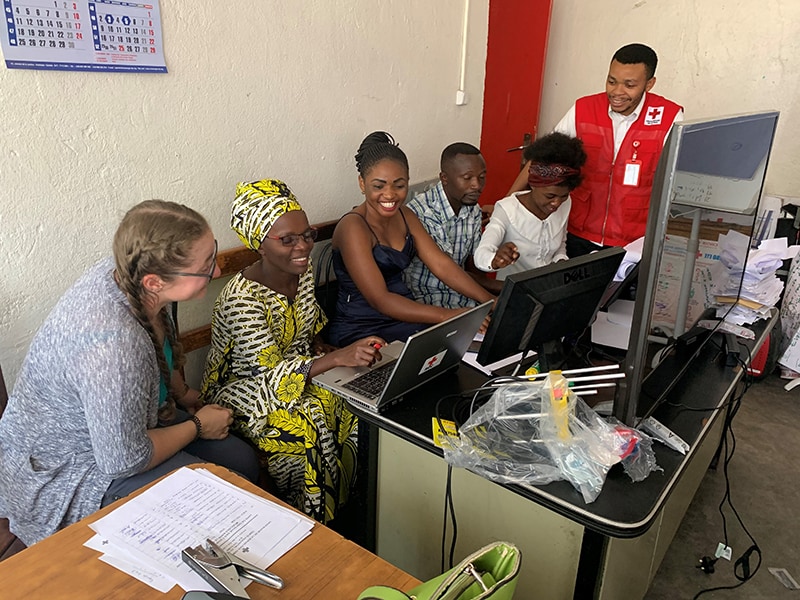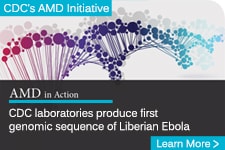How community feedback shapes the Ebola response

CDC’s Vivienne Walz, left, works with Bora Kahindo, Wivine Kabuo Mwambawsi, Justin Bisimwe, Jeanne Shabani and Héritier Malukite of the DRC Red Cross to enter comments about the Ebola response from people in communities in and around Goma
Seeing is believing, the old saying goes.
For some people who lost family to the Ebola outbreak in the Democratic Republic of the Congo, being able to see their loved ones’ remains helps build trust in the healthcare workers trying to stop the disease.
In much of the DRC, families wash the bodies of their relatives before burial. This practice puts the families at risk of contracting the Ebola virus, which is spread through contact with an infected person’s blood or bodily fluids. But placing the bodies in an opaque plastic bag denied them that opportunity to say goodbye—and fueled suspicions.
“They wanted to see, is the person whole, and is it my person?” says Christine Prue, who has led a CDC effort to support the DRC’s Red Cross in collecting and analyzing community concerns about the response. “That’s really pragmatic, and I think it’s fair.”
One relatively simple change helped break down a barrier to the response: replacing the opaque body bags with clear ones that allowed families to view the bodies. That’s led to a more favorable view of the safe and dignified burial process that’s designed to limit transmission of the disease.
“We’ve seen a definite change in people’s attitudes,” Prue says.
That improvement was the result of a months-long effort by Prue and her companions in the CDC’s Social and Behavioral Sciences group, which has been receiving text data from Red Cross, and coding and analyzing the comments from people in Ebola-stricken communities. They monitor this feedback to gain insight into how responders can adjust their tactics as they work to stop the second-worst Ebola outbreak on record.
“The beauty of this system is that it’s not an outsider coming into the community and asking them questions,” Prue says. “It’s their local community members – their neighbors—talking with them about Ebola.” As a result, “People are real, they’re raw and sometimes people are pretty confused and frustrated about how this outbreak is happening in their communities.”
The outbreak emerged in a part of the DRC where a decades-old web of conflict still simmers, leaving scores of armed groups active around the countryside. Those conflicts have left a legacy of mistrust, misinformation and hostility that have made many communities wary of outsiders.
That’s left most CDC responders unable to venture beyond Goma, the eastern city that’s become the headquarters of the Ebola response. So community volunteers for the DRC Red Cross document the comments and relay them to Prue’s group.
Unlike other behavioral science research, there’s no formal questionnaire involved—just conversations.
“It gives community members a voice,” says Vivienne Walz, who helps analyze the comments. “It’s a channel to express themselves, and it’s really important to respect that and try to act on that feedback.”
The group organizes and classifies the comments by subject. The result has been a roughly 50-page “codebook” that gets updated with new topics as they come up. Prue’s group has mined that codebook to explore Congolese attitudes about the disease, vaccination and prevention, as well as ways for communities to become more involved in the response.
The effort started within a few weeks of the outbreak’s emergence in August 2018. The group periodically shares those results with partners and CDC leaders with a goal of shaping not only this response, but how future outbreaks are handled, Prue says.
“Eight months in, we had a huge amount of data,” she says. “The real trick is getting data used.”
So far, eight volunteers from the team have deployed to the DRC. Walz, who has gone twice, calls it her “dream job” and says that being in the field with colleagues is easier and more effective than working online and across time zones.
“When you’re doing 1,000 things at once, it can seem at the microscopic level like you’re not making not much progress,” she says. “But when you zoom out and look at changes over time, it’s really encouraging.”

